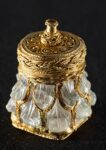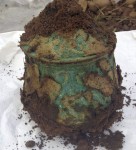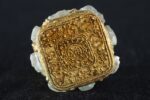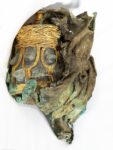 An extraordinary carved rock crystal jar from the Galloway Hoard has been cleaned and conserved by experts at the National Museums Scotland (NMS), revealing it to be a Roman crystal jar wrapped in elaborate layers of gold thread from the late 8th or early 9th century. The base is inscribed with the name of an Anglo-Saxon bishop, strong evidence that some of the treasures in the hoard were taken from a church in the early medieval Anglo-Saxon Kingdom of Northumbria.
An extraordinary carved rock crystal jar from the Galloway Hoard has been cleaned and conserved by experts at the National Museums Scotland (NMS), revealing it to be a Roman crystal jar wrapped in elaborate layers of gold thread from the late 8th or early 9th century. The base is inscribed with the name of an Anglo-Saxon bishop, strong evidence that some of the treasures in the hoard were taken from a church in the early medieval Anglo-Saxon Kingdom of Northumbria.
The richest Viking assemblage of high-status objects ever found in Britain or Ireland, the Galloway Hoard was discovered by a metal detectorist in a field near Castle Douglas in Dumfries and Galloway, Scotland in September 2014. After a major fundraising campaign, National Museums Scotland was able to acquire the hoard for an ex gratia payment of £1.98 million  ($2,550,000) in 2017. Years of complex examination, conservation and cleaning ensued, revealing an astonishing wealth of rare objects including a silver pectoral cross with niello enamel decoration that is unique on the archaeological record, a gold bird-shaped pin, also unique, and a silver-gilt pot of a type known to have been produced in the Carolingian Empire which is one of only three known from Britain and the only one of them found complete with its original lid.
($2,550,000) in 2017. Years of complex examination, conservation and cleaning ensued, revealing an astonishing wealth of rare objects including a silver pectoral cross with niello enamel decoration that is unique on the archaeological record, a gold bird-shaped pin, also unique, and a silver-gilt pot of a type known to have been produced in the Carolingian Empire which is one of only three known from Britain and the only one of them found complete with its original lid.
The pot was wrapped in woven textiles. To preserve them and excavate the interior as cautiously as possible, conservators had the pot CT scanned, revealing the treasures packed inside, including a 9th century Anglo-Saxon brooch, an Irish penannular brooch, a gold reliquary pendant and a hinged silver strap. Each object was wrapped in a precious textile like silk samite or fine leather.
While much of the Galloway Hoard outside of the pot has toured Scotland and is currently on display at Kirkcudbright Galleries in the hoard’s home region of Dumfries and Galloway, the vessel and its contents are undergoing a three-year project of meticulous conservation and research.
The project has already born extraordinary results. A 3D model created from X-ray imaging that captured the surface of the pot obscured beneath the fabric wrapping revealed it is not of Carolingian origin at all. The iconography of leopards, tigers and Zoroastrian symbols is typical of Sasanian Empire (224-651 A.D.) art, which means this vessel came from Persia, not continental Europe. Radiocarbon dating of textile samples from the three layers wrapped around the vessel found it was produced between 680 and 780 A.D., so it was 100-200 years old by the time the hoard was buried.
 One of the objects inside the vessel was the rock crystal jar. When it was first removed, it was bundled in a textile wrapping that proved to be a silk-lined leather pouch. 3D X-ray imagining saw through the wrapping to the object within and revealed the Latin inscription on the base which read: “Bishop Hyguald had me made.”
One of the objects inside the vessel was the rock crystal jar. When it was first removed, it was bundled in a textile wrapping that proved to be a silk-lined leather pouch. 3D X-ray imagining saw through the wrapping to the object within and revealed the Latin inscription on the base which read: “Bishop Hyguald had me made.”
Conservators painstakingly removed the pouch and cleaned the rock  crystal. They found from the surface of the jar that it started out as the capital of Corinthian column made of rock crystal in the late Roman Empire. At some point over the next 500 years, the capital of the crystal column was converted into a jar and wrapped in gold thread.
crystal. They found from the surface of the jar that it started out as the capital of Corinthian column made of rock crystal in the late Roman Empire. At some point over the next 500 years, the capital of the crystal column was converted into a jar and wrapped in gold thread.
There is the possibility that this jar still bears trace elements of the potion it once held and that its precise chemicals can be revealed.
[Dr. Martin Goldberg, NMS’s principal curator of early medieval and Viking collections] said: “The type of liquid that we would expect would be something very exotic, perhaps a perfume from the Orient, something’s that’s travelled in the same way that the silk has. There were certain types of exotic oil that were used in anointing kings and ecclesiastical ceremonies.”
Below are the 3D models of the rock crystal jar before and after conservation.
Excellent work! – Particularly, the first picture in full splendor is sheer marvelous.
A “Bishop Hyguald” should be rather easy to track down. I am not even a native speaker of English, but you may have noticed that there is –of course– no “Double-U” in the Latin transcript of “Hyguald”.
However, to give an example, there was an Ulrich Hugwald in 1496–1571 –in Latin, a.k.a. “Udalricus Hugualdus”, a.k.a. “Huldaricus Mutius Hugwaldus”– who ..pretended as Swiss humanist, scholar and Reformer.
:hattip:
———–
PS: I can read “Huguald”, and then maybe “Episcopus”, and maybe there is something else, i.e. a “fecit”.
PPS: “Santa’s Helper”, explained by Christoph Waltz: youtube.com/watch?v=VbkGuCozc9M :no:
Friends,
Today (18 December) the BBC is offering a parallel version of this story, with some speculation about who Hyugauld might have been. Also of interest is a photo of the crystal jar next to a human hand, which shows just how tiny this object is. Sadly, the History Blog’s structure will not allow me to post the URL. Go to BBC news, click on Scotland and scroll to near the bottom of the page for the story. You may also be able to search under “Galloway Hoard” in a few days when the story is archived.
Yours Aye,
Lord Mungo Napier, Laird of Mallard Lodge 🦆 (SCA)
Thanks Mungo Napier,
I will try to have a look. It may work, though, with a trick :p
Bishop Hugwald, therefore, is still to be identified, it seems, but there are other pictures in the links given on here, and also hints, and apparently the inscription reads:
——
+ H Y G V A L D E P : F A C : I U S S
+ Bishop Hyguald ordered [this] to be made
…–which I would render as–…
+ HUGVALD EP(iscopus) FAC(ere/iendum) IUSS(it)
——
…from “iubere”, iubeo, iussit
Those “leopards, tigers and symbols” are these here (plus, there is also what I would consider a “HUGE LOBSTER”)
nms.ac.uk/media/1164003/galloway-hoard-vessel-3d-scan-by-thinksee3d-1117×854.jpg
:hattip:
…here you go :hattip:
—–
bbc.co.uk/news/uk-scotland-south-scotland-59702916
—–
I presume it was this one (there is actually a lot of other articles on the hoard itself)
Mungo thanks to Santa’s Helper the link worked. It is tiny. Glad I saw it next to a hand because I thought it was much bigger. I thought it was exquisite in the picture, but relative to its size, it’s a remarkable piece of work.
——
From the BBC: “Experts said it was ‘frustratingly difficult’ to identify Hugwald, but he may have been a mid-9th Century bishop. […] what we do know is that there were several ecclesiastics in early medieval Northumbria with the name.”
——
What used to be a lot of single local kingdoms seems to have been replaced by ‘ealdormen’ or earls, and later by dukes. There were –at first– pagan vikings as “Danes” and –notably from 1066 onwards– christian ones as “Normans”.
For those Normans, who in the “Domesday Book” surveyed every shire in England and Wales, to calculate the dues owed to the new Norman king, it was probably a “no brainer” to erase all the records of the last 200 years and to replace the earls with new ones of their own, maybe even before their “great survey” had the new situation fixed.
The Normans possibly even installed bishops of their own. Hugwald, however, may have been Frankish, or at least a Saxon that had been –as the Frankonians put it– “made catholic”.
As lord of Ostervant (‘pagus Ostrebantinsis’) there was a Hugwald, who apparently died after 890, but I would not be surprised, if an earlier relative had been sent back to the “Nordanhymbri”.
:hattip:
———-
PS: As far as the Sasanian “giant lobster” –with its tigers and leopards– on that pot is concerned, I was remembering the “Vettersfelde Treasure” and its “giant golden fish” – with lions (and a lot more).
OK, that fish (from what today is Poland) is much older, but if ‘Scythian’, at least a relation to the Sasanian region would be given:
—
upload.wikimedia.org/wikipedia/commons/3/34/Sciti,_tesoro_di_vettersfelde_(oggi_witaszkowo_in_polonia),_500_ac_ca._pesce_d’oro_01.JPG
https://en.wikipedia.org/wiki/Vettersfelde_Treasure
—
——
From the BBC: “Experts said it was ‘frustratingly difficult’ to identify Hugwald, but he may have been a mid-9th Century bishop. […] what we do know is that there were several ecclesiastics in early medieval Northumbria with the name.”
——
What used to be a lot of single local kingdoms seems to have been replaced by ‘ealdormen’ or earls, and later by dukes. There were –at first– pagan vikings as “Danes” and –notably from 1066 onwards– christian ones as “Normans”.
For those Normans, who in the “Domesday Book” surveyed every shire in England and Wales, to calculate the dues owed to the new Norman king, it was probably a “no brainer” to erase all the records of the last 200 years and to replace the earls with new ones of their own, maybe even before their “great survey” had the new situation fixed.
The Normans possibly even installed bishops of their own. Hugwald, however, may have been Frankish, or at least a Saxon that had been –as the Frankonians put it– ..”made catholic”.
As lord of Ostervant (‘pagus Ostrebantinsis’) there was a Hugwald, who apparently died after 890, but I would not be surprised, if an earlier relative had been sent back to the “Nordanhymbri”.
:hattip:
——-
PS: As far as the Sasanian “giant lobster” –with the tigers and leopards– on that pot is concerned, I was remembering the “Vettersfelde Treasure” and its “giant golden fish” – with lions (and a lot more). OK, that fish (from what today is Poland) is much older, but if ‘Scythian’, at least a relation to the Sasanian region would be given:
—
upload.wikimedia.org/wikipedia/commons/3/34/Sciti,_tesoro_di_vettersfelde_(oggi_witaszkowo_in_polonia),_500_ac_ca._pesce_d’oro_01.JPG
en.wikipedia.org/wiki/Vettersfelde_Treasure
—
The item is about the size of a large oil stock that a bishop today might use to hold the Chrism (scented oil) that is used in the Catholic sacrament of Confirmation. The oil stocks we priests carry are much smaller, but this one would hold more oil for celebrating the sacrament for more individuals. Maybe…
A last one –I hope– from over here… :confused:
There is ‘Goldwork’ that uses metal threads, wound round a normal textile thread. The -uncommon- German term “Lahn” means flattened wire (also: ‘Plätt’, ‘Plätte’ or ‘Rausch’).
Of course, there is no textile thread with gold around it in our case, i.e. we have just “threaded gold” on that chrystal, but in general folks must have had remarkable abilities, in particularly in South-East Europe. Note that..
100µm = 0.0039370079 inch = 5.6692913 twip
3µm = 0.00011811024 inch = 0.17007874 twip
According to an article on “Ein frühmittelalterliches Goldgewebe aus Lauchheim” (A. Stauffer, F. Weisse), available from journals.ub.uni-heidelberg.de/index.php/fbbw/article/download/65773/58611/
…the goldthread used in a textile from the 6th century AD unearthed in Lauchheim was 50-100µm thick and 1-3µm thin (3µm = 0.00011811024 inch). Unfortunately, there was nothing left of the textile thread itself.
“Lahn” was paricuarly used in cloistral workshops, it seems, and it is made with what is referred to as a “Drahtplattmühle”, a “wire flattening mill” with two rolls.
It must be said: How to get a flattened gold wire of 0.0039370079 x 0.00011811024 inches around a thread of wool or silk, is far beyond my wildest imagination, but apparently it is –and has been– done.
————–
PS: On a side note:
In between what today is Bavaria and Baden-Württemberg, there is –almost next to each other– Lauchheim and Dillingen, and the first ‘Count of Dillingen’ was the “Hugwald” that I already mentioned for Ostervant: ‘Huc(p/v)ald I’, whose brother Ulrich, lat. “Uodalricus”, althd. “Uodalrîh”, was the bishop of Augsburg, St. ‘Ulrich I.’ (890–973AD).
In case any of them had been active as bishop in ‘Nordanhymbria’, there might also be records about that in Rome, who knows? – OK, I certainly do not.
PPS: At last, the dude/person, who builds ‘firefox-esr’ for Debian stable (11.2) found the means to build a rather CURRENT(!) version, so it’s http-S for me now – YEAH, BABY! :boogie:
Fascinating. Thanks for sharing.